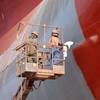Bureau Veritas has joined
forces with leading yacht designers and builders to completely
re-engineer its Rules for Classification and Certification of Yachts.
The new Rules, launched today, build on Bureau Veritas' extensive
experience with high-technology vessels and materials to provide
designers and builders with a safe, pragmatic, robust and rationale
framework for yachts of all sizes.
Etienne Thiberge, Head the hull department of the Marine Technical
Division for Bureau Veritas, says, "The explosive growth in the mega
yacht market poses enormous safety challenges. Setting up a safety
framework for high tech pleasure vessels, especially those over 24m LOA
but under 500 gt requires a careful balancing of technical freedom with
pragmatic limits on safe outcomes. We have worked hard with experienced
yards, surveyors, and operators of all types and sizes of yachts to get
that pragmatic framework, and have combined it with our very detailed
knowledge of the behaviour of modern materials such as composites to
produce a set of Rules which will allow designers to let their
imaginations free while keeping the crews and passengers safe and
comfortable."
The Bureau Veritas Yacht Rules cover all structural, electrical,
stability and fire safety requirements for all sizes and types of
pleasure vessel, and also contain cross references to Flag Sate and EU
regulatory requirements. Sail or power, mono or multi-hull, commercial
or not, these Rules will provide the requisite safety framework for the
structure, stability, fire safety, power and electrical installation and
mooring and anchoring outfit.
Says Thiberge, "We have to take account of the way yachts are pushing
the technical frontiers of shipping, and they way they are used, and
realise that simply adapting rules for ordinary ships is rarely
sufficient. A lot of the yachts being built and conceived today are
breaking new technological frontiers. Also, when in use, the owners want
comfort, which means, in safety terms, how do we allow for spaces with a
lot of comfortable but combustible furnishings? These new Rules combine
experience with technology and provide a safe but not restricted design
platform."
Subscribe for
Maritime Reporter E-News
Maritime Reporter E-News is the maritime industry's largest circulation and most authoritative ENews Service, delivered to your Email five times per week










